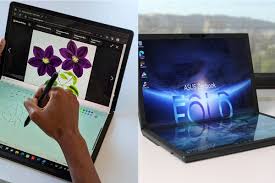
Foldable phones have moved from futuristic concepts to mainstream reality in just a few short years. In 2025, devices like the Samsung Galaxy Z Fold 6, Huawei Mate X5, and Google Pixel Fold 2 have matured into polished, durable, and highly capable products. With prices becoming more accessible and foldable screens now boasting better longevity and practicality, the foldable revolution is well underway.
But this raises a bigger question: now that foldable phones are here, **what’s next for foldable technology?
Let’s take a look at where the innovation is heading.
1. Rollable Phones and Tablets
If foldables defined the early 2020s, rollables might define the late 2020s.
Several companies, including Motorola, Samsung, and Oppo, have already teased working prototypes of rollable displays that expand horizontally or vertically at the push of a button. Instead of folding a screen, a hidden portion simply *rolls out* to enlarge the display.
Key advantages of rollables:
• Thinner form factors than foldables
• Seamless expansion without a visible crease
• More natural phone-to-tablet transformations
In the coming years, expect rollable smartphones and even rollable tablets to start appearing commercially — offering even more flexible design options.
2. Foldable Laptops and Large-Screen Devices
While smartphones led the foldable movement, larger devices are next in line.

In 2025, foldable laptops like the Asus Zenbook Fold and Lenovo ThinkPad X1 Fold are gaining traction. These devices feature a large flexible OLED screen that can act as both a full tablet and a clamshell laptop with a virtual or physical keyboard.
What’s next?
• Triple-fold laptops: Devices that fold into thirds, offering larger 20+ inch displays in ultra-portable formats.
• Hybrid desktop solutions: Foldable all-in-one PCs that can be compact for travel but expand to full workstation sizes.
Foldable laptops could change how we think about work, play, and portability — particularly with AI-enhanced multitasking and modular accessories.
3. Wearables with Flexible Displays :Foldable screens aren’t limited to phones and laptops. The next generation of wearables will feature flexible, stretchable displays.
Innovations on the horizon include:
• Wraparound smartwatches: Displays that curve around the entire wrist, offering more screen space and interactivity.
• Flexible fitness bands: Devices that contour perfectly to the body and adjust display size depending on need.
• Smart clothing: Research into textiles embedded with flexible OLED displays could lead to jackets, shirts, and accessories that display dynamic information.
These advancements will blur the lines between fashion, technology, and communication even further.
4. Foldable Accessories and Smart Home Devices
Flexible tech could also invade the home.
Imagine:
• Foldable smart speakers: with wraparound displays that expand to show more information when needed.
• Foldable TVs: that roll out from a compact box or even *disappear into furniture* when not in use.
• Portable foldable monitors for mobile workstations or on-the-go gaming setups.
Brands like LG and Samsung are already showcasing concepts like rollable TVs and slidable displays at tech expos. The home entertainment market is poised to be the next playground for foldable innovation.
5. Challenges Ahead
Despite the excitement, foldable tech still faces hurdles:
• Durability concerns remain, especially with rollables and stretchables.
• Manufacturing costs are high, slowing mass adoption.
• Battery technology needs to catch up to support thin, foldable designs without sacrificing longevity.
As the technology matures, solving these challenges will be key to making foldable devices truly mainstream across all categories.
Final Thoughts: Beyond the Fold
Foldable phones were just the beginning. In the next few years, expect foldable, rollable, and stretchable screens to move beyond phones and infiltrate laptops, wearables, smart homes, and even fashion.
The real promise of foldable tech is about more than just bending screens — it’s about reshaping how we interact with the digital world, making devices more adaptive, more personal, and more seamlessly integrated into our lives.
In 2025 and beyond, the future of foldable technology isn’t just flexible — it’s limitless.
